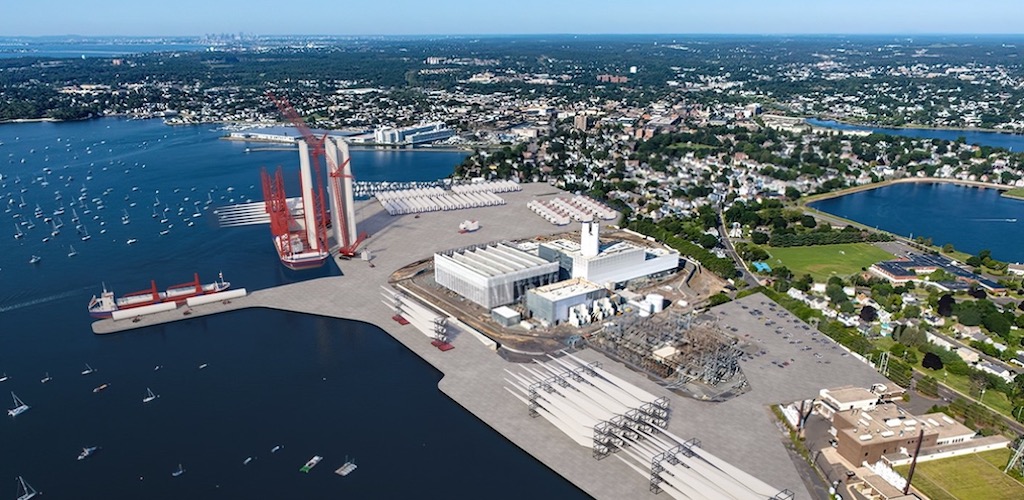Vineyard Wind Offshore Project Sparks Development

By Malcolm Ramsay
Developers behind the 804-megawatt Vineyard Wind offshore project in Massachusetts recently signed an agreement with engineering group Crowley Maritime to develop Salem Harbor into the state’s second major offshore wind port.
Located about 13 nautical miles south of Martha’s Vineyard and Nantucket, Vineyard Wind is the first commercial-scale offshore wind farm in the U.S. to achieve financial close, and is expected to be the first of many following successful offshore wind lease sales by the U.S. Bureau of Ocean Energy Management, or BOEM.
Avangrid Renewables and investment group Copenhagen Infrastructure Partners submitted the "Commonwealth Wind" initiative in September. If approved, it will involve development of a further 1.2 gigawatts of wind power in an area 22 miles south of Martha's Vineyard.
Crowley will work with the project’s developers local authorities to improve breakbulk handling services across the Salem Port area
David DeCamp, director of corporate communications for Crowley, told Breakbulk the deal will see the firm marshalling a wide variety of project cargo such as “foundations and other materials” as well as “wind turbine generator components, blades, towers, nacelles” to support installation construction.
A joint venture between energy firm Avangrid Renewables and investment group Copenhagen Infrastructure Partners, Vineyard Wind is expected to create a total of 900 full-time equivalent jobs over the first five years of operation for construction and staging for wind projects and day-to-day port operations.
Rapidly Growing Industry
Featuring 84 GE Haliade-X turbines, Vineyard will involve significant breakbulk transport during construction, but prior to this phase the partners need have identified the need to create a suitable staging area to receive and prepare the various outsized cargoes.
“As offshore wind continues to expand, new purpose-built ports will be key to the success of this industry. By constructing the nation’s first purpose-built offshore wind port in New Bedford, Massachusetts has been leading the way. With a new offshore wind port in Salem, the Commonwealth can ensure that it is ready to face the demands of a rapidly growing industry,” Lars T. Pedersen, CEO of Vineyard Wind, says.
The Vineyard Wind project has so far secured almost US$2.3 billion of senior debt and financial backers include some of the biggest names in banking, including Bank of America, J.P. Morgan, BBVA, NatWest, Santander, Crédit Agricole, Natixis, BNP Paribas and MUFG Bank.
Bill White, head of offshore wind for Avangrid Renewables, predicts that the partnership will act as a demonstrator for the transition from coal into sustainable infrastructure and help attract investment numerous similar locations in the U.S.
“Commonwealth Wind is a transformational project that will create good jobs, economic opportunity and clean electricity for Massachusetts, facilitated by this important partnership with the City of Salem and Crowley,” White notes.
Long-term Offshore Wind Port
Under the terms of the agreement, Crowley Wind Services will purchase an area of 42 acres surrounding Salem Harbor Station from current owner Footprint Power and serve as the long-term offshore wind port operator.
Headquartered in Jacksonville, Florida, Crowley Maritime is a primarily focused on vessel management and supply chain logistics but has invested heavily in energy transition pivoting to become a leader in LNG and sustainability. The group operates in 35 nations and island territories via four core business units: Crowley Logistics, Crowley Shipping, Crowley Solutions and Crowley Fuels.
Crowley recently opened a new Rhode Island office to advance development and operation of offshore wind energy installations. Located at CIC Providence in the Innovation and Design District, the office will support its New Energy division and provide both landside and marine logistics solutions during all phases of project lifecycle.
In Salem, Crowley plans to build a range of facilities for turbine assembly and staging activities, including dedicated cargo handling systems for blades, nacelles, and tower section. DeCamp of Crowley explains that the firm also plans to deploy a fleet of cranes and self-propelled modular trailers at the site to support movement between storage zones.
The existing port at Salem dates back hundreds of year and has been developed into a deepwater harbor to serve large-scale coal carriers, hence providing unrestricted height access to accommodate large-scale wind turbine installation vessels.


